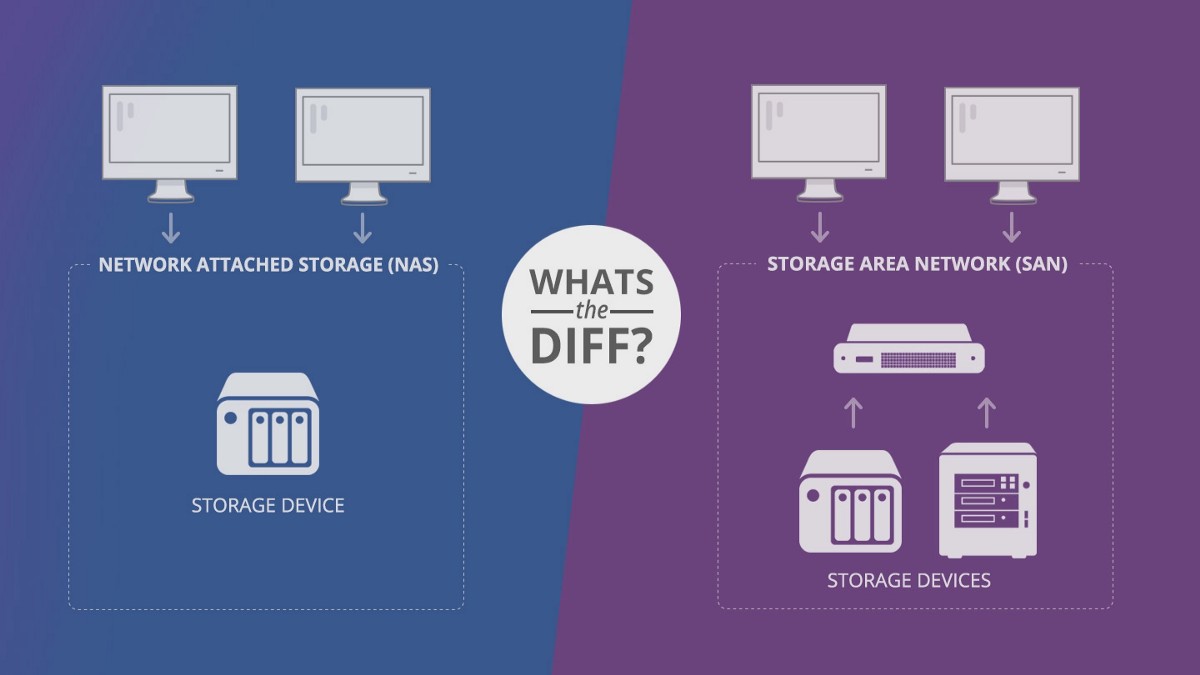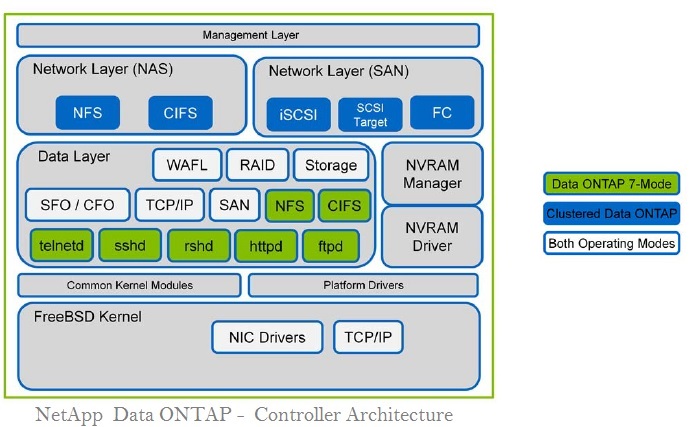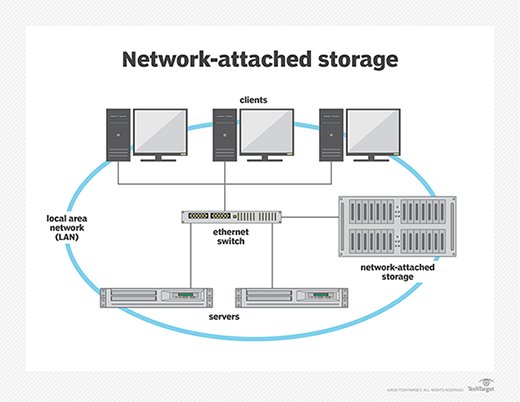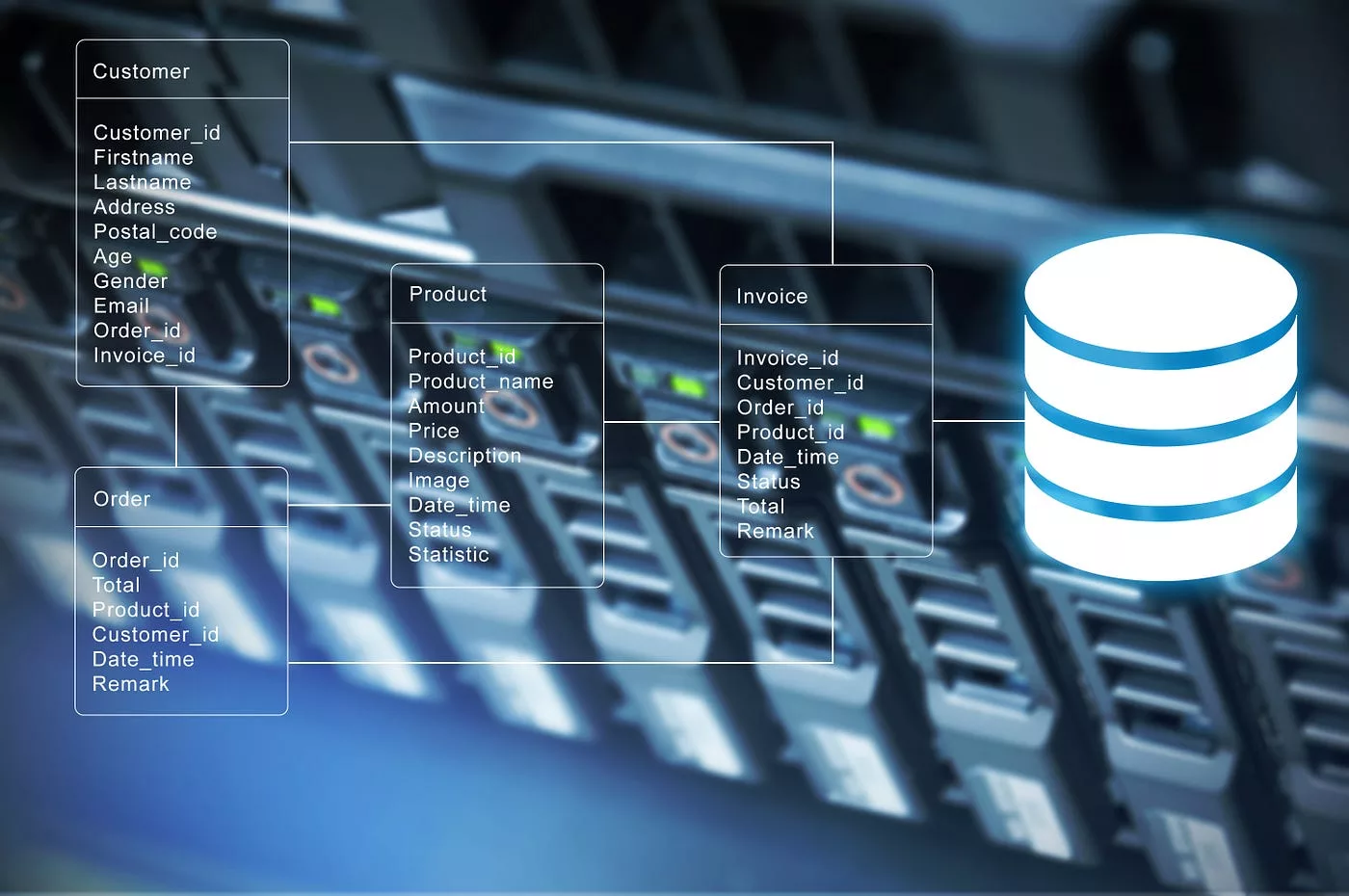NAS (network-attached storage) and SAN (storage area networks) were created to address making stored data accessible to many users at the same time. Each of them provides storage for a set of customers, but their approaches to accomplishing their goals could not be more dissimilar.
A NAS is dedicated storage of basic instrument data via Ethernet and is affordable and simple to set up. In contrast, a SAN is a closely linked network of several machines that is more costly and difficult to set up and run. From the user’s perspective, the primary distinction between NAS and SAN is that NAS devices supply storage devices as network-mounted volume and then use technologies including NFS and SMB/CIFS, whereas SAN-connected discs look like local discs.
This post will go through the distinctions between NAS and SAN and the kind of applications they’re best suited for to help you decide which is ideal for you.
What Is NAS and What Does It Mean?

Image Source: Link
A networked storage area network (NAS) is a computer that delivers folder file storage capabilities to other networked devices. The ease with which NAS may be set up and deployed is its primary advantage. The user sees NAS volumes as network-mounted volumes. The files to be delivered are usually stored on one or all of the system’s hard drives, which are often organized in RAID arrays. The more drive ports a NAS has, the more storage space and flexibility you’ll have.
The device is a network node, similar to laptops and other TCP/IP devices, which all have their IP address, and the NAS file service sends and receives files via the Ethernet network. NAS manufacturers and third parties are starting to offer additional software to provide server-like capabilities on a NAS, despite the fact that a NAS is often not intended to function as a comprehensive server.
Whenever users work on things or share information, NAS devices provide an easy approach for many users in different places to access data. NAS supports collaboration by offering quality access controls and security and allowing non-IT professionals to administer and manage data access via an on-board web server. It also provides strong fundamental data resiliency by using redundant data structures—often RAID—to make numerous drives appear as a single, huge volume capable of withstanding the breakdown of a few of its drives.
NAS Advantages
:max_bytes(150000):strip_icc()/san-vs-nas-818005-9e14f35c271a4f0388d7be3740cc2fe4.png)
Image Source: Link
NAS is often the next level up for an office or a local company currently employing external drives or direct-attached at storage, both prone to drive failure. The wish to share files local and remote, to have files available 24/7, to achieve data redundancy, to be able to replace and update hard disks in the system, and, most importantly, to support connectivity with cloud services that provide a position for necessary fully automated backup data are all driving factors for upgrading to NAS.
Benefits of NAS in Brief:
- It’s a rather low-cost option.
- A self-contained solution.
- Administration is simple.
- Data is available 24 hours a day, seven days a week, and can be
- There is a large selection of technologies and sizes to pick from.
- Drive storage volumes that can withstand failure.
- Backup tapes to additional devices and the internet are done automatically.
NAS’s Limitations

Image Source: Link
A NAS’s flaws are connected to its size and performance. The server may not even be capable of keeping up as more people request access. You could extend the storage at this point. Still, you’ll almost certainly need to replace it with a more powerful machine with a quicker onboard processor, greater memory, and larger internet connectivity. The other flaw has to do with Ethernet’s inherent nature. Ethernet is designed to transport data from one location to another by dividing the source into multiple data packets and delivering them to their destination. Depending on network traffic or challenges, any of the packets could be delayed or sent out of order.
What Is SAN and What Does It Mean?
Image Source: Link
A storage area network (SAN) provides users with high-performance, low-latency shared storage. A storage area network (SAN) comprises servers and storage connected by a high-speed, low-latency interconnect that permits immediate Fibre Channel connection from the customer to the storage volume for the best performance. The SAN may require a different, dedicated Ethernet network between both the server and clients to keep file request traffic separate from other traffic. In demanding environments such as videography, where files are notably large, even a delay of a few microseconds can disrupt manufacturing processes like video editing. While for small files, users typically don’t notice the delay.
Getting more performance out from the Fiber Channel network in demanding applications such as video editing or several application servers, a SAN provides a flexible approach to deliver cloud service for many users. Fibre Channel storage traffic avoids TCP/IP packetization and delays concerns.
Data Management and Accessibility: Examining the Data Management and Accessibility Capabilities of SAN and NAS Systems
Examining the Data Management and Accessibility Capabilities of SAN and NAS Systems:
SAN: SAN systems are designed for high-performance, block-level data access. They provide direct access to storage devices, making them ideal for applications that require low latency and high throughputs, such as databases or virtualization environments. SANs offer advanced features for data management, including features like snapshots, replication, and thin provisioning. These capabilities allow for efficient data organization, backup, and recovery. However, SANs typically require specialized knowledge and administration expertise to manage and configure.
NAS: NAS systems, on the other hand, provide file-level data access over a network. NAS solutions, designed for shared storage and file-sharing scenarios, offer easy setup and management, making them suitable for environments that prioritize simplicity and ease of use. They offer features like file-level snapshots, quotas, and access controls, enabling effective data management and accessibility. Commonly, you can use NAS systems for centralized file storage, home directories, and collaboration platforms.
Overall, SANs are ideal for performance-driven applications needing direct block-level access, while NAS systems are better for scenarios emphasizing file sharing and ease of use.
Cost Considerations: Evaluating the Expense and Factors Involved in Deploying SAN and NAS Solutions.
Use Cases and Applications: Understanding the Common Use Cases and Applications of SAN and NAS in Different Environments
Assessing the Cost Factors and Considerations for Implementing SAN and NAS Solutions
SAN:
Implementing a SAN infrastructure typically involves higher upfront costs compared to NAS. SANs require specialized hardware, such as Fibre Channel switches and Host Bus Adapters (HBAs), which can be expensive. Additionally, SAN deployments often require dedicated IT staff with specialized knowledge for configuration, maintenance, and troubleshooting.
NAS:
NAS solutions tend to have a lower initial investment compared to SAN. The systems leverage existing network infrastructure, eliminating the need for additional dedicated hardware. They are typically easier to set up and manage, which can reduce ongoing administrative costs. Additionally, NAS systems can use commodity hardware, further lowering the overall cost.
When considering cost, it’s essential to evaluate the specific requirements of your environment and the level of performance and scalability needed. While SANs may have higher initial costs, they may offer advantages in performance-intensive applications.
Data Security and Protection: Addressing the Data Security and Protection Measures Provided by SAN and NAS Solutions
Addressing the Data Security and Protection Measures Provided by SAN and NAS Solutions
SAN:
SANs offer robust security features to protect data. They typically incorporate features like access controls, zoning, and LUN (Logical Unit Number) masking to restrict access to authorized users and prevent unauthorized access. SANs also support data encryption at rest and during transmission to safeguard sensitive information. Regular data backups and replication can further enhance data protection and disaster recovery capabilities.
NAS:
NAS systems provide various security measures to protect data integrity and confidentiality. Access controls, user authentication mechanisms, and file-level permissions ensure authorized access to data. NAS solutions often include built-in security features like firewall protection and secure remote access protocols (e.g., SSH or SSL/TLS). Implementing proper backup and disaster recovery strategies is crucial to ensure data resilience and protection.
Management and Administration: Comparing the Management and Administration Complexity of SAN and NAS Systems
SAN:
SANs typically require a higher level of expertise and administration due to their complex nature. They involve specialized hardware components, such as Fibre Channel switches and HBAs, which demand in-depth knowledge for installation, configuration, and troubleshooting. SAN administration often involves tasks like zoning, masking, and LUN management to ensure proper data access and security. As SANs scale, managing storage provisioning and capacity planning becomes critical to maintain optimal performance.
NAS:
In contrast, NAS systems are generally easier to manage and administer. They leverage existing network infrastructure and utilize standard protocols like NFS (Network File System) or SMB (Server Message Block). NAS setup involves simple configurations, and many NAS solutions provide user-friendly web-based interfaces for administration tasks. These interfaces offer intuitive controls for user management, access permissions, and data management features like snapshots and quotas. NAS systems typically offer automated data replication and backup options, simplifying data protection and disaster recovery processes.
Overall, the design of NAS solutions caters with ease of use and simplicity in mind, making them more accessible to users with limited technical expertise. SANs, on the other hand, require a deeper understanding of storage networking concepts and may necessitate dedicated IT staff with specialized skills to handle the complexity of the infrastructure.
Conclusion
In conclusion, SAN and NAS both have a wide variety of uses depending on the needs of an organization. Each technology has its own strengths and weaknesses that you should take into consideration when making any purchase decisions. As far as performance goes, SANs offer higher speeds than NAS units due to their distributed architecture, whereas NAS provides more storage capacity per dollar spent. The decision ultimately comes down to what the outcome that you desire is and how much money you can invest in each system. In either case, it is critical to understand the specifics of your business requirements before investing in either solution so that you get exactly what you need from a cost-benefit standpoint.
FAQs on SAN vs. NAS (Storage Area Network vs. Network Attached Storage)
What is the fundamental difference between SAN and NAS?
SAN (Storage Area Network) is a dedicated network that connects servers to storage devices, providing block-level storage access. On the other hand, a network attached storage (NAS) device connects to a network, enabling multiple clients to access shared file-level storage.
Which one would suit better for which type of environment: SAN or NAS?
Typically, environments requiring high-performance, low-latency access to block-level data, such as database servers or virtualized environments, prefer SAN (Storage Area Network). NAS is more suitable for file-sharing applications, serving documents, multimedia files, and backups to multiple users or clients over the network.
What are the primary advantages of SAN over NAS?
SAN offers advantages such as higher performance, lower latency, better scalability for block-level storage, and support for advanced features like data replication and snapshotting. It’s also suitable for applications requiring direct disk access, such as databases and virtualization.
What are the key advantages of NAS when you compare it to SAN?
NAS provides simplicity and ease of management since it operates at the file level, making it ideal for file-sharing environments. It offers seamless integration into existing network infrastructure, simplified backup and recovery processes, and support for common file protocols like NFS and SMB/CIFS.
Can you use SAN and NAS together in the same environment?
Yes, integrating SAN and NAS within the same environment to meet different storage requirements is possible. This approach, often referred to as unified or converged storage, allows SAN and NAS protocols to coexist within the same storage system, providing flexibility and versatility in addressing various storage needs.
Which one is more cost-effective: SAN or NAS?
The cost-effectiveness depends on factors such as the specific requirements of the environment, scalability needs, performance expectations, and management complexity. Generally, NAS solutions tend to be more cost-effective for file-sharing applications with lower performance demands, while SAN solutions may incur higher initial costs but offer better performance and scalability for block-level storage.
What are the considerations when deciding between SAN and NAS for a new deployment?
Considerations encompass the type of applications and workloads needing support, performance requirements, scalability needs, budget constraints, existing infrastructure, management complexity, and future growth plans. Consulting with storage experts and conducting a thorough assessment of requirements can help determine the most suitable solution for the specific use case.





